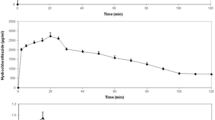Abstract
A microscopic mass balance approach has been developed to predict the fraction dose absorbed of suspensions of poorly soluble compounds. The mathematical model includes four fundamental di-mensionless parameters to estimate the fraction dose absorbed: initial saturation (Is), absorption number (An), dose number (Do), and dissolution number (Dn). The fraction dose absorbed (F) increases with increasing Is, An, and Dn and with decreasing Do. At higher Dn and lower Do, the fraction dose absorbed reaches the maximal F, which depends only on An. The dissolution number limit on F can appear at both lower Do and lower Dn. Likewise, at higher Do and Dn, the fraction dose absorbed reaches a Do limit. Initial saturation makes a significant difference in F at lower Do and Dn. It is shown that the extent of drug absorption is expected to be highly variable when Dn and Do are approximately one. Furthermore, by calculating these dimensionless groups for a given compound, a formulation scientist can estimate not only the extent of drug absorption but also the effect, if any, of particle size reduction on the extent of drug absorption.
Similar content being viewed by others
REFERENCES
B. C. Goodacre and R. J. Murray. A mathematical model of drug absorption. J. Clin. Hosp. Pharm. 6:117–133 (1981).
N. F. H. Ho, H. P. Merkle, and W. I. Higuchi. Quantitative, mechanistic and physiologically realistic approach to the biopharmaceutical design of oral drug delivery systems. Drug Dev. Ind. Pharm. 9:1111–1184 (1983).
J. B. Dressman, D. Fleisher, and G. L. Amidon. Physicochemical model for dose-dependent drug absorption. J. Pharm. Sci. 73:1274–1279 (1984).
J. B. Dressman, G. L. Amidon, and D. Fleisher. Absorption potential: Estimating the fraction absorbed for orally administered compounds. J. Pharm. Sci. 74:588–589 (1985).
J. B. Dressman and D. Fleisher. Mixing-tank model for predicting dissolution rate control of oral absorption. J. Pharm. Sci. 75:109–116 (1986).
P. J. Sinko, G. D. Leesman, and G. L. Amidon. Predicting fraction dose absorbed in humans using a macroscopic mass balance approach. Pharm. Res. 8:979–988 (1991).
D.-M. Oh, P. J. Sinko, and G. L. Amidon. Predicting oral drug absorption in humans: A macroscopic mass balance approach for passive and carrier-mediated compounds. In D. Z. D'Argenio (ed.), Advanced Methods of Pharmacokinetic and Pharmacodynamic Systems Analysis, Plenum Press, New York, 1991, pp. 3–11.
N. F. H. Ho, J. Y. Park, P. F. Ni, and W. I. Higuchi. Advancing quantitative and mechanistic approaches in interfacing gastrointestinal drug absorption studies in animals and humans. In W. Crouthanel and A. C. Sarapu (eds.), Animal Models for Oral Drug Delivery in Man: In Situ and In Vivo Approaches. American Pharmaceutical Association, Washington, DC, 1983, pp. 27–106.
R. B. Bird, W. E. Stewart, and E. N. Lightfoot. Transport Phenomena, John Wiley & Sons, New York, 1960, p. 647.
W. I. Higuch and E. N. Hiestand. Dissolution rates of finely divided drug powders. I. Effect of a distribution of particle size in a diffusion-controlled process. J. Pharm. Sci. 52:67–71 (1963).
D.-M. Oh. Estimating Oral Drug Absorption in Humans, Ph.D. thesis, University of Michigan, Ann Arbor, 1991.
G. L. Amidon, P. J. Sinko, and D. Fleisher. Estimating human oral fraction dose absorbed: A correlation using rat intestinal membrane permeability for passive and carrier-mediated compounds. Pharm. Res. 5:651–654 (1988).
D.-M. Oh, R. L. Curl, and G. L. Amidon. Effect of micronization on the extent of drug absorption from suspensions in humans (submitted for publication).
Author information
Authors and Affiliations
Rights and permissions
About this article
Cite this article
Oh, DM., Curl, R.L. & Amidon, G.L. Estimating the Fraction Dose Absorbed from Suspensions of Poorly Soluble Compounds in Humans: A Mathematical Model. Pharm Res 10, 264–270 (1993). https://doi.org/10.1023/A:1018947113238
Issue Date:
DOI: https://doi.org/10.1023/A:1018947113238




